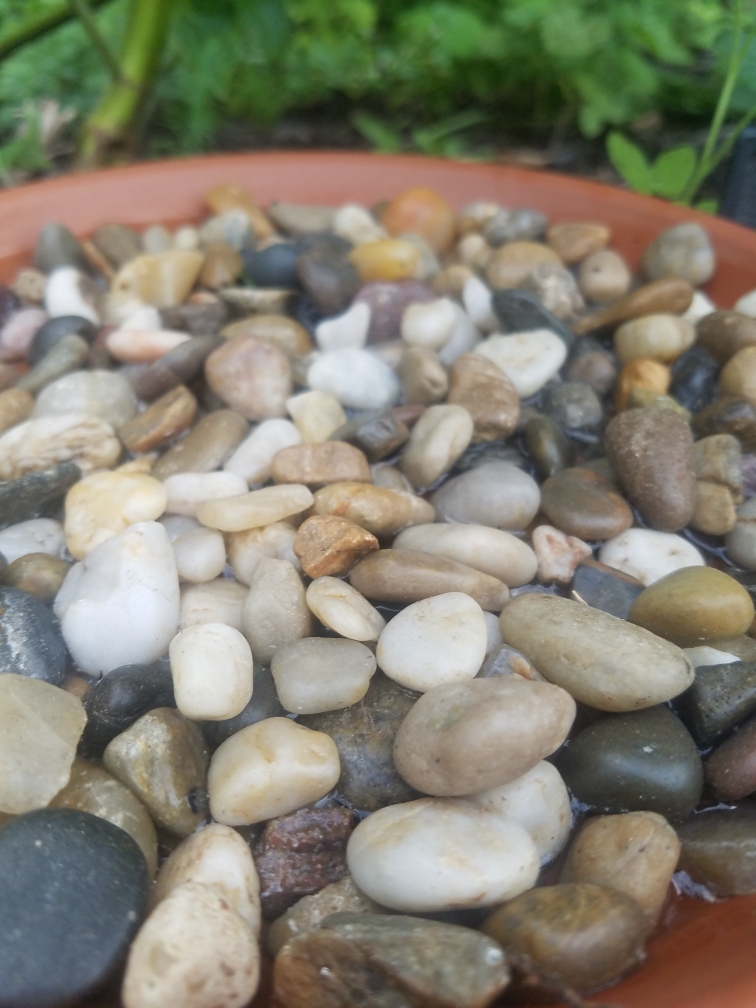Now that you have started to acquire some animal remains, you may find yourself wondering how to clean them. Of course, if you buy from an online retailer they will come nice and cleaned to you, but finding them in nature is another story. I have some bones I have found that I haven't cleaned because I loved how they looked and the animal spirit residing in the bone or skull wished for it to remain just the way I found it. The coyote skull I have is one such example. If you have seen it in my rituals, spells, and altars, the skull is covered in lichen. Eventually, the skull will break down, but I respectfully left the skull as it was at the request of the coyote spirit. Other bones and skulls I have, however, either don't have a spirit or the spirit was totally fine with me cleaning their vessel. Always ask before you clean any bones you found. The last thing you want to do is upset the animal spirits or drive them away from their resting place.
So how should you clean the animal remains you find? This is by no means going to be a complete guide, but I have included links to articles and videos to fill in the gaps.
Disclosure: Some of the links below are affiliate links, meaning, at no additional cost to you, I will earn a commission if you click through and make a purchase.
Bones
There are several methods to clean bones if you so wish. Most people agree that bleach, even in low concentrations, is harmful to the bones and will cause degradation over time so you will find no bleach here!
1. Flesh Removal
If you come across bones that still have flesh on them, such as roadkill or bones purchased from a butcher, you need to begin by removing the flesh. You have several options here depending on time, equipment, and smell tolerance!
Slow Cooker Method 1
First and foremost, you don't want to boil the bones. Boiling causes the bones to become weak and brittle, just as cooking them does. I know lots of people used chicken bones from rotisserie chickens, and that is perfectly fine, but the bones are much more brittle and prone to breakage than bones that have not been cooked or boiled.
For the first slow cooker method, all you will need is a slow cooker, slow cooker liner (to prevent the flesh from permeating into your slow cooker and to help with clean up), water, and the remains. Remove as much flesh as possible prior to cooking. This can take some time and if the remains have begun to rot, this is going to smell horrid. Place the liner in the slow cooker. Sit the remains in the liner and fill with water until the remains are covered. Set the slow cooker to 165
° F or the low/medium setting. Make sure to check your manual to figure out which setting will be closest to 165
° F. Again, you do not want to boil the remains. Depending on the size of the remains, it should cook anywhere between 4 and 24 hours. A pig head takes about 24 hours. If it is larger than a pig head, you're going to need to cook it longer, but I can't fit anything larger than that in my slow cooker so you'll likely go with a different method.
After cooking the remains, you will need to remove any remaining flesh and scrub the bones well with dish soap. Nonscoring pads, dish brushes, and bottle brushes are best for this as they won't scratch or damage the bones. Again, this is going to smell horrid, especially if there is any brain left behind. You might want a mask and some candles burning.
Slow Cooker Method 2
This method uses all of the above items as well as a biological washing powder to speed up the process and make the bones easier to clean. A biological washing powder is any powdered detergent that contains enzymes. These enzymes break down the fats and proteins in the remaining flesh, making it easier to remove whatever remains after cooking. To find a biological powder, look for any powdered detergent that contains enzymes (protease) or order some
Bio-Tex off Amazon.
As before, place everything in the slow cooker and set your slow cooker to a low setting. Add 1-2 tablespoons of biological washing powder. Depending on the remains, allow to slow cook for 4-24 hours. You want the water to remain warm throughout the process but not hot, otherwise, the enzymes will not activate or will denature. At low temperatures, the enzyme protease will not function. At high temperatures, protease will break down (denature) and no longer work. Once the remains are removed from the slow cooker, be sure you wash them really well to remove all the enzymes and remaining flesh. You don't want the enzymes to continue breaking down the bone!
Maceration
This method is often referred to as the "cold" water method and smells awful, but it is super effective for small remains like fish, amphibians, bats, and mice. You will need a large plastic bucket with a lid or a mason jar for really small remains. Place the animal remains, with as much flesh removed as possible, in the bucket or jar and fill with warm water until the remains are covered. Do not use hot or boiling water as it will kill the bacteria. Cover the container, but do not completely seal it. Lack of oxygen will slow down the process. Sit in a warm location, under a heat lamp (mason jar), or place an aquarium incubator into the bucket set to 95
° F. You want the temperature to remain around 95
° F for the duration of the process to help the process. After two days, change the water, leaving some of the original water in the container to maintain the bacteria colony. You can remove flesh from the remains at this time as well, especially if there is a lot of fat left behind. You don't want the fat to accumulate in the bones. One day 5, check the remains again. If there is still a lot of tissue left, allow the remains to macerate longer. This process can take up to 14 days. After 14 days, remove the remains and clean them as best you can.
Dermestid Beetles
If you have space and you know what you are doing, dermestid beetles, aka flesh-eating beetles, are a less smelly way to clean your bones. However, you are going to need to consistently provide your beetles with food, so if you are only looking to clean a few remains, dermestid beetles are not for you. They should also be kept in a large tank with proper bedding in a warm place. If they get too cold they won't eat. Furthermore, dermestid beetles are best for small remains with little flesh. It takes time for the beetles to eat and if there is too much flesh on the bones, the inner flesh will begin to rot. Dermestid beetles prefer fresh flesh to rotting flesh. If you want to use larger remains, remove some of the flesh prior to feeding the beetles. It can take anywhere from a couple of days to a couple of weeks for the beetles to do their work. Once they are done, simply follow one of the cleaning methods below. You can order a dermestid beetle kit
here or call local wildlife centers and taxidermists to see if they have beetles open to public use.
Burial
This method is easy, less smelly, but time-consuming and slightly risky. If done incorrectly, you can end up preserving the entire animal, losing bones, or damaging them. If you plan to bury, leave the animal remains above ground for 2-3 days. This will allow flies to lay eggs. Once the larvae hatch (maggots) they will begin eating the flesh, even if buried underground. If you are burying smaller remains, place them in a thin muslin bag to keep the remains together. For larger animals, you might consider a wire mesh. Bury the remains in drier soil. Avoid very wet soil and sand as this can preserve the remains. Mark where you buried the remains and allow them to sit for several months. The larger the remains, the longer they should remain buried.
Laying Out
This is super risky and smelly but effective. Leaving animal remains to rot on the surface do so quickly and effectively, but you run the risk of humans and animals alike making off with your remains. However, Mother Nature is much better at cleaning bones than we are. Simply leave the remains above the surface for 3-12 months depending on the location and size of the remains. You will want to cover them in a wire mesh or cage to prevent animals and humans from taking the remains. Foxes and coyotes will run off with bits and pieces and take them miles away if you're not careful. Another method is to place smaller remains underneath a weighted flower pot. This allows flies to move in and out and keeps predators out.
2. Degreasing
Degreasing the bones is an important step if you used many of the methods above. While you don't have to degrease the bones if you laid them out of buried them, it is still a useful cleaning step so why not do it anyway? Simply mix together warm water and Dawn dish soap and allow the bones to sit in the water-soap solution for 24 hours. This will remove both dirt and fat residue left over from the defleshing process.
3. Bleaching (without bleach!)
There are two methods to "bleaching" or whitening bones. The first is the hydrogen peroxide method, which also helps sterilize the bones. The second is sunning them I do during the drying process. Once you have cleaned and degreased the bones, place them in a container and cover with 3% hydrogen peroxide. This will disinfect and bleach the bones without causing them to degrade. It can take 3 hours to a week for the bones to whiten to the color you wish them to be. Make sure there are no air bubbles trapped and the bone is completely covered.
4. Drying
After everything is said and done, allow the bones to air dry in the sun if possible for a couple of days. If they are not completely dry after a couple of days, place them on some newspaper and allow them to dry near a heat source. Do not place them directly on the heat source as this could cause the bone to crack.
Feathers
Feathers have a very different process of cleaning than bones. They are much more fragile and don't need to have any fleshed removed. You can clean them in a soapy water bath or wipe them down with baby wipes. When you dry them, be sure to rub them back into the correct position and dry them on a flat surface. Do not place in direct sunlight. After washing and drying them, place them in the freezer for about a week to kill any bugs or mites that may still be left on the feathers.
If you are looking at preserving an entire bird wing, try the borax method. In a cardboard box, sprinkle an inch of borax on the bottom. Place the bird wing on top of the borax then cover it with a thin layer of borax. The borax will dry out the tissue and mummify the wing while simultaneously disinfecting the feathers.
Other Animal Remains
Most other animals remain such as teeth, claws, and shells can be cleaning with soap and water. Furs and pelts can be washed in a mild soap and water bath and should be immediately hung up to dry in a warm place. Do not place pelts or furs in the sun as this will cause fading. Organs and organ tissue should be preserved in a preservative fluid as recommended by a taxidermist. If you are looking to use something quickly in a spell, like a fresh sheep heart or cow tongue, usually the spell requires burying or tossing the parts away after use. Store these items in a fridge or freezer prior to use.
Below are some amazing resources regarding cleaning and preserving animal remains.
Cleaning and Preserving Animal Skulls by the University of Arizona Cooperative Extension
Jake's Bones (blog)- Covers everything you could possibly think of regarding cleaning animal remains.
Bones at Home- how to properly care for your bones once they are clean
Sanitizing Feathers for Crafts by Dara Trahan
The Best Way to Clean Seashells Without Ruining Them by Dawn Henthron
Wet Specimens- A General Guide by Mickey Alice Kwapis
Wet Specimens- An Updated Post (with a little history lesson) by Mickey Alice Kwapis
Link Round Up- Bone Cleaning by Mickey Alice Kwapis
Whatever method you chose, always make sure you are following safe procedures and following all local laws. If you are concerned about smell, legality, time, or space, buying bones from an ethical online source is fine. It doesn't make you less witchy to buy them. Do you have a preferred cleaning method?
Interest in the rest of the series? Here's what's to come!
Bone Magic Series











